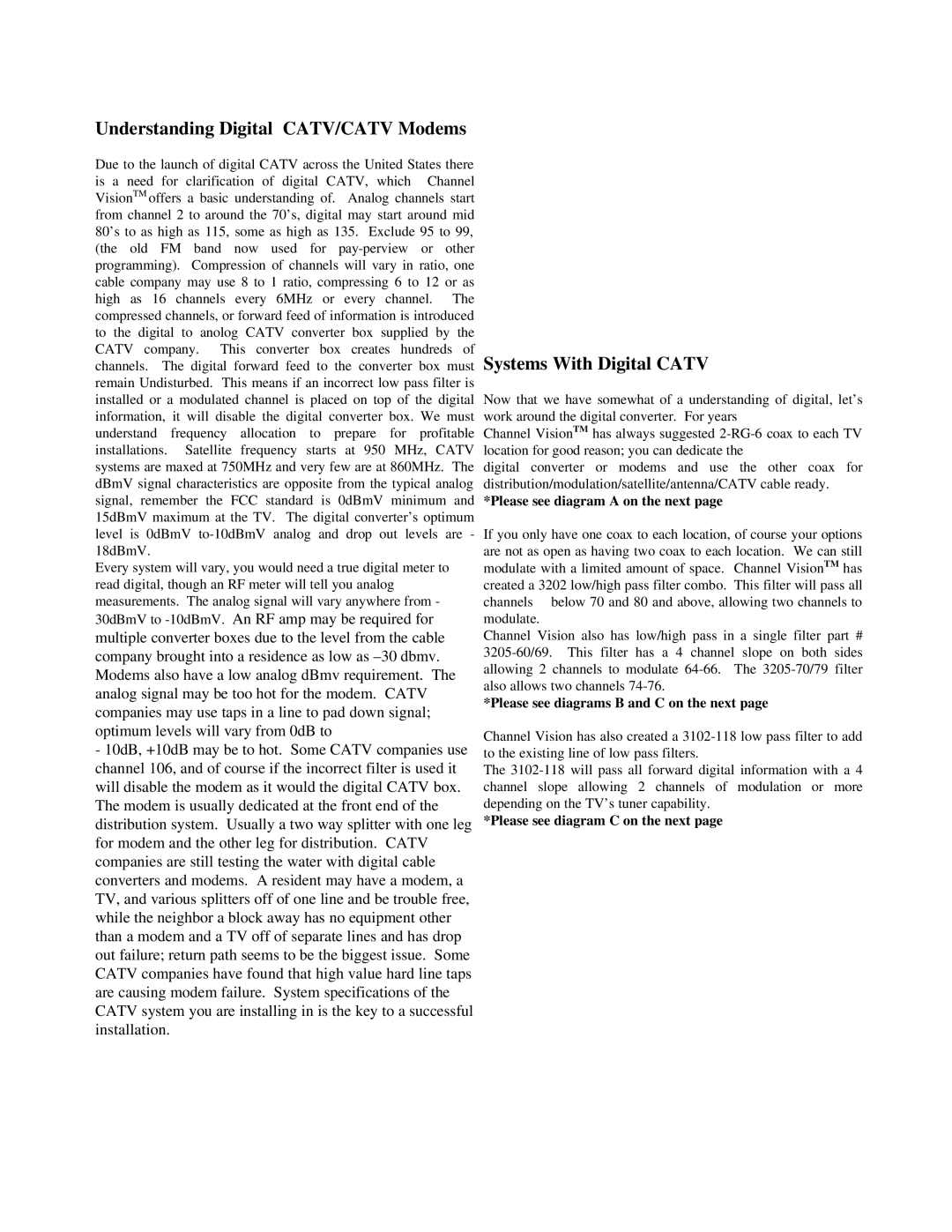Understanding Digital CATV/CATV Modems
Due to the launch of digital CATV across the United States there |
|
| |||
is a need | for | clarification of digital CATV, which Channel |
|
| |
VisionTM offers a basic understanding of. Analog channels start |
|
| |||
from channel 2 to around the 70’s, digital may start around mid |
|
| |||
80’s to as high as 115, some as high as 135. Exclude 95 to 99, |
|
| |||
(the old FM band now used for |
|
| |||
programming). Compression of channels will vary in ratio, one |
|
| |||
cable company may use 8 to 1 ratio, compressing 6 to 12 or as |
|
| |||
high as 16 channels every 6MHz or every channel. The |
|
| |||
compressed channels, or forward feed of information is introduced |
|
| |||
to the digital to anolog CATV converter box supplied by the |
|
| |||
CATV company. This converter box creates hundreds of | Systems With Digital CATV |
| |||
channels. | The | digital forward feed to the converter box must |
| ||
remain Undisturbed. This means if an incorrect low pass filter is |
|
| |||
installed or a modulated channel is placed on top of the digital | Now that we have somewhat of a understanding of digital, let’s | ||||
information, it will disable the digital converter box. We must | work around the digital converter. For years | ||||
understand frequency allocation to prepare for profitable | Channel VisionTM has always suggested | ||||
installations. | Satellite frequency starts at 950 MHz, CATV | location for good reason; you can dedicate the | |||
systems are maxed at 750MHz and very few are at 860MHz. The | digital converter or modems and use the other coax for | ||||
dBmV signal characteristics are opposite from the typical analog | distribution/modulation/satellite/antenna/CATV cable ready. | ||||
signal, remember the FCC standard is 0dBmV minimum and | *Please see diagram A on the next page |
| |||
15dBmV maximum at the TV. The digital converter’s optimum |
|
| |||
level is 0dBmV | If you only have one coax to each location, of course your options | ||||
18dBmV. |
|
| are not as open as having two coax to each location. We can still | ||
Every system will vary, you would need a true digital meter to | modulate with a limited amount of space. | Channel VisionTM has | |||
read digital, though an RF meter will tell you analog | created a 3202 low/high pass filter combo. This filter will pass all | ||||
measurements. The analog signal will vary anywhere from - | channels below 70 and 80 and above, allowing two channels to | ||||
30dBmV to | modulate. |
| |||
multiple converter boxes due to the level from the cable | Channel Vision also has low/high pass in a single filter part # | ||||
company brought into a residence as low as | |||||
Modems also have a low analog dBmv requirement. The | allowing 2 channels to modulate | The | |||
also allows two channels |
| ||||
analog signal may be too hot for the modem. CATV |
| ||||
*Please see diagrams B and C on the next page | |||||
companies may use taps in a line to pad down signal; | |||||
|
| ||||
optimum levels will vary from 0dB to | Channel Vision has also created a | ||||
- 10dB, +10dB may be to hot. Some CATV companies use | |||||
to the existing line of low pass filters. |
| ||||
channel 106, and of course if the incorrect filter is used it | The | ||||
will disable the modem as it would the digital CATV box. | channel slope allowing 2 channels of modulation or more | ||||
The modem is usually dedicated at the front end of the | depending on the TV’s tuner capability. |
| |||
distribution system. Usually a two way splitter with one leg | *Please see diagram C on the next page |
| |||
for modem and the other leg for distribution. CATV |
|
| |||
companies are still testing the water with digital cable |
|
| |||
converters and modems. A resident may have a modem, a |
|
| |||
TV, and various splitters off of one line and be trouble free, |
|
| |||
while the neighbor a block away has no equipment other |
|
| |||
than a modem and a TV off of separate lines and has drop |
|
| |||
out failure; return path seems to be the biggest issue. Some |
|
| |||
CATV companies have found that high value hard line taps |
|
| |||
are causing modem failure. System specifications of the |
|
| |||
CATV system you are installing in is the key to a successful |
|
| |||
installation. |
|
|
| ||
